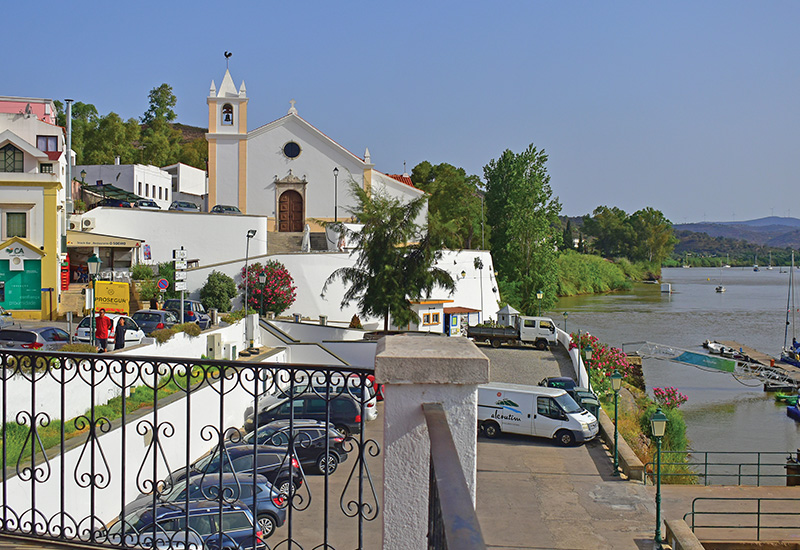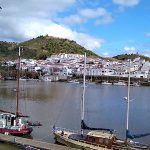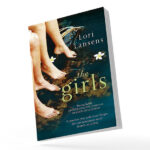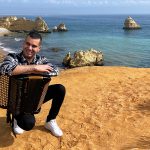Alcoutim revisited – a model of collective cooperation
Not long ago, I wrote about the Festival do Contrabando and now I find myself revisiting Alcoutim for a different reason. Partly because this charming riverside town left an impression on me and also to announce another very good excuse to visit again later in the year.
But first, there was a nagging question from that article that was only partly answered about why there was ever a town built here in the first place. It really is in the middle of nowhere in one of the least populated regions of the country. After some further digging, an interesting discovery was uncovered. To the north of Alcoutim lies the now abandoned São Domingos Copper Mine. It had been mined from Roman times until the early 1960s (and possibly earlier) and the prize was iron and copper ore.
From the nearest river port of Pomarão, this precious metal was loaded onto boats and transported down the Guadiana river to the estuary at Vila Real de Santo António. The 8th century Moorish castle also suggests a more military origin, to defend the river border. This created a need for some basic facilities, which led to the building of a village over time. The rest is history, as they say, but no village in a remote area is going to survive without a resource.

Today, I am meeting up with some people who live and work here and it is very clear that collective cooperation is a major factor in how this community works, with more value than any soft metal. My conversation with Paul, an influential member of the ex-pat community here, is relaxed and easygoing. I was impressed with both his passion for this place and his desire to give something back to the village that’s received him and others so warmly. He is doing this by organising a free music festival, and not for the first time either, but for the ninth. With a glint in his eye, he comments that having missed a year due to the pandemic, they will try to get away with calling it their tenth anniversary.
It is only a matter of days after our first phone chat and here we are already discussing how an art exhibition can be incorporated into a music festival, with others in the community, including officials from the freguesia, already briefed and in agreement with our initial plans. After just a couple of hours of walking around to look at potential venues for showing art, the evidence that residents and visitors are well catered for is clearly seen. For such a small town to boast a beach that is fed with fresh water from a nearby lake, an event/concert hall for an audience of up to 150, a youth hostel and a library inside one of the town’s historical buildings (among other attractions) is impressive.
As my host for the morning points out, hospitality is the only real source of income for many of the locals and it is one that is taken very seriously. It was suggested to me that this kind of collaboration between the freguesia and the community it supports is unique, and it certainly makes a really refreshing change to what I usually come across when trying to organise things in summer. Very refreshing indeed!

Another huge cultural factor here is music and it is clear that something about the area attracts musicians. If you are a musician you can go along to the big Sunday jam which is always popular with performers and audiences. As we pass the Praça da Republica in the town centre, equipment is being set up for one of the regular Wednesday concerts; to talk about other events held throughout the year would require another article. Residents, along with well-recognised bands from around the country, play here on a regular basis and the Guadiana International Music Festival in October will be another occasion when they will do so again. Visit their website musicaguadiana.org for more information.
For me, the event represents a shining example of what I am writing about, a group of people who are willing to give up their time, and share their resources and experience to give back to their community by arranging their own event with musicians who will perform for no financial gain and a local council that is willing to support their efforts. And it’s free for us all to attend and enjoy. Glastonbury, it won’t be: from the heart and authentic, it certainly will.
For the first time in its history, art will be included as an integral part of the event. The Artlink collective will be working in association with local artists and exhibiting there with the ambition of adding another dynamic for visitors and another level of collective collaboration.
On my way home (with the relief of air conditioning in the car), I found myself reflecting on how the history of the old Roman mines still resonates in the musical performances of today. Copper combines with zinc to make brass, which is used to make a whole range of musical instruments because it is more malleable and has better acoustic properties than copper or zinc alone.
The manufacture of brass or copper-coated guitar strings is a science in its own right and without them electrified guitar riffs and finger-picking, acoustic blues just would not sound as good as they do. And of all the simple pleasures in life, this is among those that I can’t imagine living without.
My conclusion is simple, I have my hotel room booked.
Photos © Bob Tidy
Main image: Paul Doody, the principal organizer of the Festival













